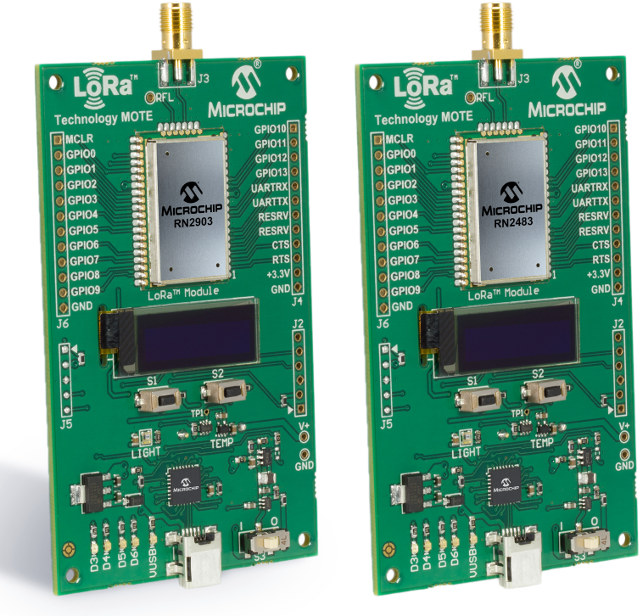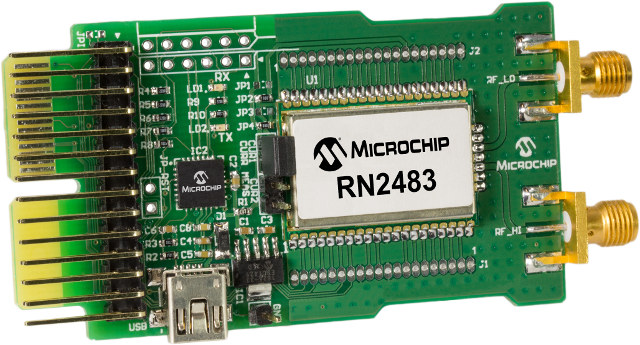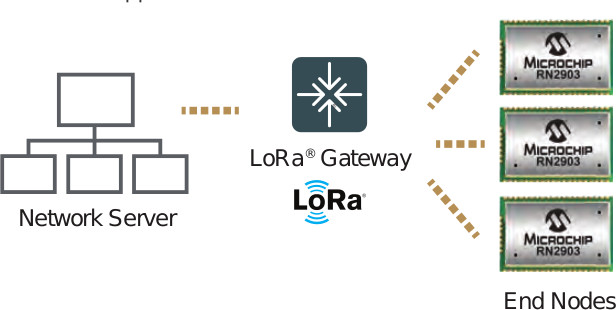LoRa is one of those long range low power WAN standards used for the machine to machine (M2M) and Internet of things (IoT) applications. I already featured a Semtech Lora module here with a line-of-sight range of up to 20 to 30km, and the company has just partnered with STMicro to deploy LoRa solutions, but today, I’m going to have a look at Microchip Lora modules and development kits that I discovered in the company’s Micro Solutions Nov/Dec 2015 publication.
The company has launched two modules for the European and North American markets with respectively RN2483 LoRa 433/868 MHz R&TTE Directive Assessed Radio Modem and RN2903 915 MHz North American modem. Apart from the different frequencies, both modules have similar features:
- On-board LoRaWAN Class A protocol stack
- Tx/Rx Power
- RN2483 – 40 mA (14dBm, 868MHz) Tx, and 14.2 mA Rx @ 3.6V
- RN2903 – 124 mA Tx max, and 13.5 mA Rx @ (2.1 to 3.6V)
- ASCII command interface over UART
- Castellated SMT pads for easy and reliable PCB mounting
- Device Firmware Upgrade (DFU) over UART
- 14 GPIO for control, status, and ADC
- Highly integrated module with MCU, crystal, EUI-64 Node Identity Serial EEPROM, Radio transceiver with analog front end, and matching circuitry
- Operating Voltage – RN2483: 3.6V; RN2903: 2.1V to 3.6V
- Dimensions – 17.8 x 26.7 x 3 mm
- Operating Temperature Range – -40C to +85C
- FCC and IC Certified, RoHS compliant
Demo source code, datasheets, product briefs, and user’s guides are available on the modules’ product pages linked above.

The first development tool is LoRa Technology Mote with either RN2483 @ 868 MHz or RN2903 @ 915 MHz. It is a standalone battery-powered LoRa node, used to to demonstrate the long-range capabilities of the modem, and verify inter-operability with LoRaWAN v1.0 gateways and infrastructure. The key features listed for Lora Motes:
-
- MCU – Microchip PIC18LF25K50 8-bit MCU
- Connectivity
- EU version (RN2483) – 868 MHz High-Frequency SMA Connector & 433 MHz Low-Frequency Antenna test Point
- US version (RN2903) – 915 MHz High-Frequency SMA Connector
- Display – OLED display; 128 x 64 resolution
- USB – USB Mini-B Connector
- Sensors – Ambient Light Sensor, Linear Active Thermistor (MCP9700T)
- Programming / Debugging – Mote ICSP Programming
- Misc – S1 & S2 buttons for menu navigation, 4x LEDs controlled by PIC18 (2), and module (2), battery power switch
- Power – 2x AAA Battery Pack; LDO Regulator (MCP1825S); alternative power supply through hole connectors
- Dimensions – N/A

The second options is RN2483/RN2903 LoRa Technology PICtail/PICtail Plus daughter boards that can be connected to PIC18 Explorer or Explorer 16 development boards, with the latter supporting PIC24, dsPIC, or PIC32 MCU families.
LoRa PICTail daughter board specifications:
- US version – Microchip RN2903 Low-Power Long Range, LoRa Technology Transceiver Module with one SMA connector for 915 MHz band
- EU version – Microchip RN2483 LoRa Technology Transceiver Module with two SMA connectors for 433 MHz and 868 MHz bands
- MCU – PIC18 MCU for custom functions
- USB – 1x mini USB connector
- Expansion interfaces
- Solder pads around the module for GPIOs, power pins and communication signals
- PICtail connection interface
- PICtail Plus connection interface
- Programming – ICSP header to program the on-board PIC18 MCU
- Misc – UART traffic LEDs
- Power Supply – On-board LDO; supply current measurement points
- Dimensions – N/A
You can find user’s guides and some extra documentation for all four kits on their respective product pages: RN2483 LoRa Technology Mote, RN2903 LoRa Technology Mote, RN2483 LoRa Technology PICtail (Plus) Daughter Board, and RN2903 LoRa Technology PICtail (Plus) Daughter Board.

Both RN2483 and RN2903 modules are available now for $10.90 each in 1,000-unit quantities, while LoRa Technology Motes go for $69.99 and LoRa PICTail boards for $65 on microchipDIRECT or other distributors.

Jean-Luc started CNX Software in 2010 as a part-time endeavor, before quitting his job as a software engineering manager, and starting to write daily news, and reviews full time later in 2011.
Support CNX Software! Donate via cryptocurrencies, become a Patron on Patreon, or purchase goods on Amazon or Aliexpress






Pretty nice if this “Laura” does indeed give you km of range.
@Marius Cirsta
The range is stated in the video (around 1m30s/1m35s): “up to 10 miles” (around 16km)
http://www.disk91.com/2015/technology/networks/first-step-in-lora-land-microchip-rn2483-test/
So p2p networks are possible, but unfortunately there doesn’t seem to be support to run small user applications on the internal mcu.
@Paulin ARBOUX
Sure but what happens when multiple Lauras collide ? For now I expect that the Laura spectrum is not very crowded but it might be soon enough.
@Marius Cirsta
I don’t know how that works but LoRaWAN supports one million device per access point (Uplink), and 100,000 for downlink. Data rate is limited to 50 kpbs for Europe, and 100 kbps for the US. Based on that table: http://www.cnx-software.com/2015/09/21/comparison-table-of-low-power-wan-standards-for-industrial-applications/
@Deets
If you get the module only (as the post linked), you can’t program the receiver, but if you get one of the motes, you should be able to program the included PIC18 MCU to control the GPIOs, buttons and OLED display yourself, otherwise why would they have included those?
From that post… useful app to calculate LoRa bitrate, range, power consumption, etc… tradeoffs -> http://www.semtech.com/apps/filedown/down.php?file=SX1272LoRaCalculatorSetup1%271.zip (Windows only)
@cnxsoft
you might be able to do voip over that speed…
Until a very active community is up like esp8266, then other IoT/M2M platforms can make a point of interesting.
Today not only platform itself can drive to that point but a key success is a social developer community one.
@cnxsoft
Yes but who wants to spend $70 when there is a perfectly capable MCU on the module (to do simple tasks like read a sensor)? Other modules ship with sdks or have built-in sensor functions for standalone operation. Lorawan code is on github. Certainly possible to just roll your own firmware from scratch.
The thing is for the home automation I want to do I really have no need for Laura but for something that needs longer ranges or a mesh throughout the city this would indeed be useful, provided that it really does work for km in real world conditions.
@zoobab
I’m not even sure that 50kbps / 100kbps is sustainable over longer distances. I think LoRa has been designed to send sensor data at low bitrate over a few kilometers.
@Deets
I agree that it’s not ideal. And I’ve double checked RN2483 won’t run in standalone mode. The GPIOs on the module itself need to be controlled via the UART interface….
Not sure if you guys noticed it, but at least in Europe there is a quite big LoRaWAN hype at the moment. Big providers are pushing into the market, while initatives like the things network build their own free networks.
At the moment the RN module is quite neat, cause it runs it own stack and can be controlled by AT commands. It some guys are able to hack it, like they did it with the ESP, it will become a cool module.
But yesterday I saw the specs of a board, sporting a LoRa radio chip plus a cortex M0, which will maybe get an arduino compatible bootloader, and will cost round 20 bucks.
@Till O’Rly
If you are not under NDA, feel free to share that solution. A link would be welcomed too.
new PR two days ago -> http://www.microchip.com/pagehandler/en-us/press-release/microchips-lora-is-worlds-firs.html entitled “Microchip’s LoRa Wireless Module is World’s First to Pass LoRa Alliance Certification; Ensures Interoperation of Long-Range, Low-Power IoT Networks”
A couple of months ago I bought RN2483 and I connected it to by laptop with Ubuntu. It was interesting the learn how to use it directly with minicom and here is a short video tutorial: https://www.youtube.com/watch?v=o_Jij8mQ8ts
Can anyone share a demo code on how to connect a lora device rn-2903 lora mote from microchip